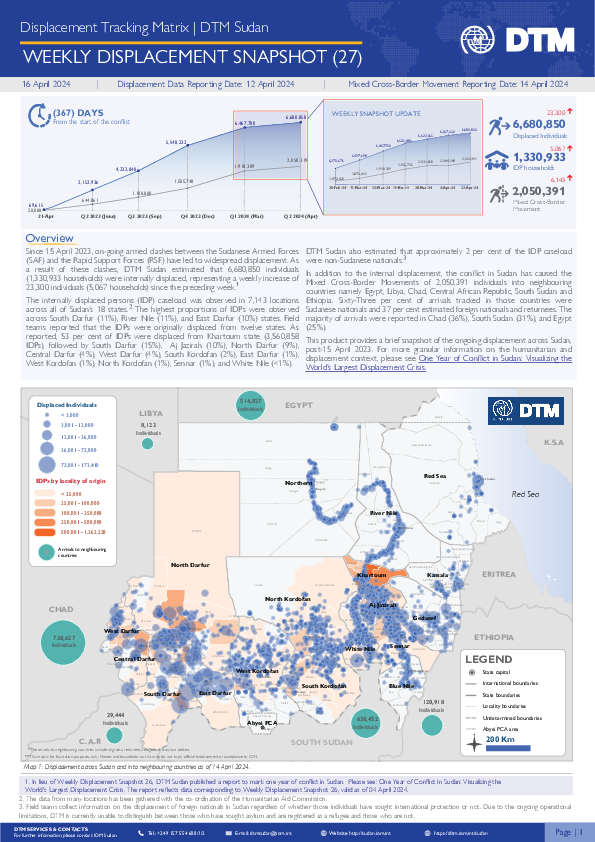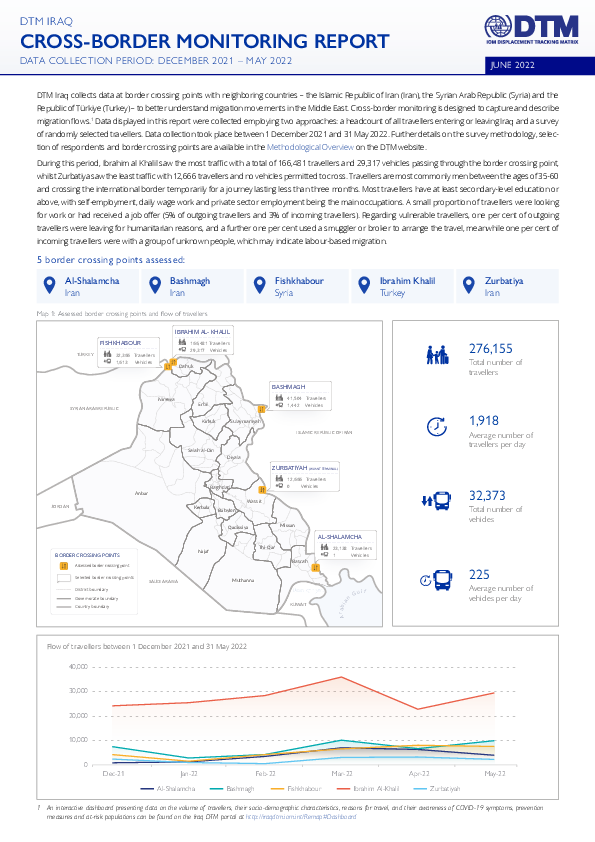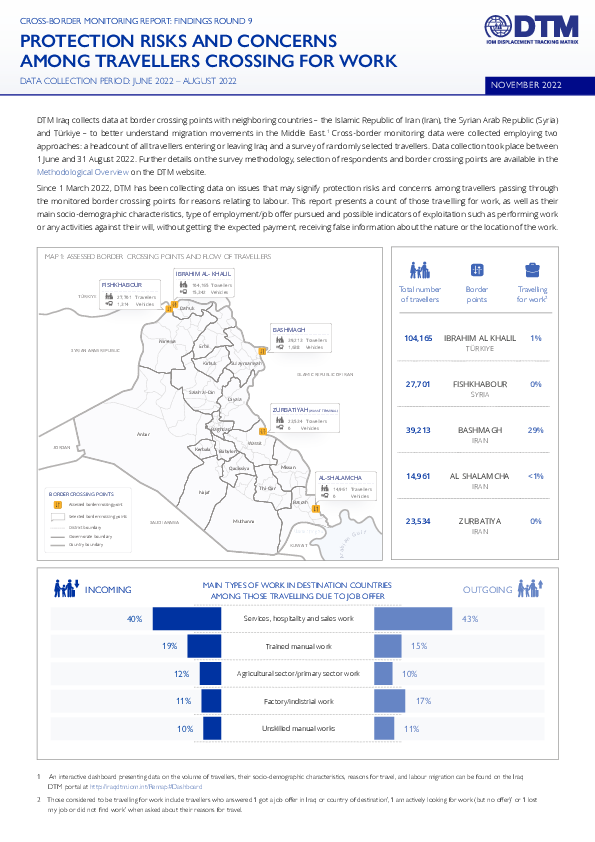-
Countries
-
Data and Analysis
-
Special Focus
-
Crisis Responses

Contact
iomguatemala@iom.int
Language
English
Location
Guatemala
Period Covered
Feb 01 2024
Feb 29 2024
Activity
- Flow Monitoring
En febrero de 2024 se observaron 22,402 movimientos en Guatemala (18% niños, niñas y adolescentes) y 400 personas fueron encuestadas.1 El número de movimientos observados disminuyó un 6 por ciento desde enero de 2024 (23,690) debido a limitaciones operativas en la recolección de datos. Más de la mitad de las personas encuestadas procedía de la República Bolivariana de Venezuela (63%). El principal destino previsto fue los Estados Unidos de América (90%).
Desde 2022, los flujos de migrantes en tránsito se incrementaron significativamente en la región de América Latina y el Caribe, observando cantidades nunca antes registradas de personas que cruzan la peligrosa selva del Parque Nacional del Darién desde Colombia hacia Panamá. Los flujos en tránsito observados en Guatemala han reflejado dichas tendencias migratorias regionales

Contact
DTM Sudan; dtmsudan@iom.int
Language
English
Location
Sudan
Period Covered
Apr 05 2024
Apr 12 2024
Activity
- Mobility Tracking
- Baseline Assessment
Overview
On 15 April 2023, armed clashes erupted between the Sudanese Armed Forces (SAF) and the Rapid Support Forces (RSF) in multiple cities across Sudan. Clashes initially took place in cities across Northern and Khartoum states, later spreading across the Darfur and Kordofan regions.
Highlights
- DTM Sudan estimates that 6,680,850 individuals (1,330,933 households) were recently internally displaced.
- The IDP caseload was observed in 7,143 locations across all of Sudan’s 18 states.
- The highest proportions of IDPs were observed across South Darfur (11%), River Nile (11%), and East Darfur (10%).
- Field teams reported that the IDPs observed were originally displaced from twelve states. The majority (3,560,858 IDPs, 54%) were reportedly displaced from Khartoum state; followed by South Darfur (15%), Aj Jazirah (10%), North Darfur (9%), Central Darfur (4%), West Darfur (4%), South Kordofan (2%), East Darfur (1%), West Kordofan (1%), North Kordofan (1%), Sennar (1%) and White Nile (<1%).
- IOM-DTM also reported that an estimated 2,050,391 mixed cross-border movements were made into neighbouring countries.
- This product provides brief insights into those displaced in Sudan post-15 April 2023. For more granular information on the IDP caseload and the displacement context, please see IOM-DTM's One Year of Conflict in Sudan: Visualizing the World's Largest Displacement Crisis.
Note: In lieu of Weekly Displacement Snapshot 26, DTM Sudan published a report to to mark one year of conflict in Sudan. Please see: One Year of Conflict in Sudan: Visualizing the World's Largest Displacement Crisis. The report reflects data corresponding to Weekly Displacement Snapshot 26 dataset, valid as of 04 April 2024.

Contact
IraqDTM@iom.int
Language
English
Location
Iraq
Period Covered
Dec 01 2021
May 30 2022
Activity
- Survey
- Flow Monitoring
DTM Iraq collects data at border crossing points with neighboring countries – the Islamic Republic of Iran (Iran), the Syrian Arab Republic (Syria) and the Republic of Türkiye (Turkey) – to better understand migration movements in the Middle East. Cross-border monitoring is designed to capture and describe migration flows. Data displayed in this report were collected employing two approaches: a headcount of all travellers entering or leaving Iraq and a survey of randomly selected travellers. Data collection took place between 1 December 2021 and 31 May 2022. Further details on the survey methodology, selection of respondents and border crossing points are available in the Methodological Overview on the DTM website.
During this period, Ibrahim al Khalil saw the most traffic with a total of 166,481 travellers and 29,317 vehicles passing through the border crossing point, whilst Zurbatiya saw the least traffic with 12,666 travellers and no vehicles permitted to cross. Travellers are most commonly men between the ages of 35-60 and crossing the international border temporarily for a journey lasting less than three months. Most travellers have at least secondary-level education or above, with self-employment, daily wage work and private sector employment being the main occupations. A small proportion of travellers were looking for work or had received a job offer (5% of outgoing travellers and 3% of incoming travellers). Regarding vulnerable travellers, one per cent of outgoing travellers were leaving for humanitarian reasons, and a further one per cent used a smuggler or broker to arrange the travel, meanwhile one per cent of incoming travellers were with a group of unknown people, which may indicate labour-based migration.

Contact
IraqDTM@iom.int
Language
English
Location
Iraq
Period Covered
Dec 01 2022
Feb 28 2023
Activity
- Survey
- Flow Monitoring
DTM Iraq collects data at border crossing points with neighbouring countries – the Islamic Republic of Iran (Iran), the Syrian Arab Republic (Syria) and the Republic of Türkiye (Türkiye) – to better understand migration movements in the Middle East. Cross-border monitoring is designed to capture and describe migration flows. Data displayed in this report were collected employing two approaches: a headcount of all travellers entering or leaving Iraq and a survey of randomly selected travellers. Data collection took place between 1 December 2022 and 28 February 2023. Further details on the survey methodology, selection of respondents and border crossing points are available in the Methodological Overview on the DTM website.
From December 2022 to February 2023, Ibrahim al Khalil saw the most traffic with a total of 90,586 travellers and 16,864 vehicles passing through the border crossing point, whilst Al-Shalamcha saw the least traffic with 6,149 travellers and no vehicles permitted to cross. Most travellers were males and middle-aged (35–60 years old) crossing an international border for a journey lasting less than three months. The majority of travellers have a secondary or vocational education degree, with self-employment and private sector employment being the main employment statuses. A small proportion of travellers were looking for work or had received a job offer (6% of incoming travellers and 4% of outgoing travellers). Regarding protection risks, one per cent of travellers entered Iraq for humanitarian reasons, and less than one per cent entered Iraq with a group of unknown people. It was observed that the number of people crossing the border drastically dropped a day after a 7.8 magnitude earthquake struck on 6 February 2023. The border monitoring team also reported various types of vehicles transporting relief for people affected by the Earthquake in Türkiye and Syria crossing Ibrahim Al-Khalil border point.

Contact
IraqDTM@iom.int
Language
English
Location
Iraq
Period Covered
Jun 01 2022
Aug 31 2022
Activity
- Survey
- Flow Monitoring
DTM Iraq collects data at border crossing points with neighboring countries – the Islamic Republic of Iran (Iran), the Syrian Arab Republic (Syria) and Türkiye – to better understand migration movements in the Middle East.1 Cross-border monitoring data were collected employing two approaches: a headcount of all travellers entering or leaving Iraq and a survey of randomly selected travellers. Data collection took place between 1 June and 31 August 2022. Further details on the survey methodology, selection of respondents and border crossing points are available in the Methodological Overview on the DTM website.
Since 1 March 2022, DTM has been collecting data on issues that may signify protection risks and concerns among travellers passing through the monitored border crossing points for reasons relating to labour. This report presents a count of those travelling for work, as well as their main socio-demographic characteristics, type of employment/job offer pursued and possible indicators of exploitation such as performing work or any activities against their will, without getting the expected payment, receiving false information about the nature or the location of the work.

Contact
IraqDTM@iom.int
Language
English
Location
Iraq
Period Covered
Sep 01 2022
Nov 30 2022
Activity
- Survey
- Flow Monitoring
DTM Iraq collects data at border crossing points with neighboring countries – the Islamic Republic of Iran (Iran), the Syrian Arab Republic (Syria) and the Republic of Türkiye (Türkiye) – to better understand migration movements in the Middle East. Cross-border monitoring data were collected employing two approaches: a headcount of all travellers entering or leaving Iraq and a survey of randomly selected travellers. Data collection took place between 1 September and 30 November 2022. Further details on the survey methodology, selection of respondents and border crossing points are available in the Methodological Overview on the DTM website.
Following previous period, DTM team continuing its efforts of collecting data on issues that may signify protection risks and concerns among travellers passing through the monitored border crossing points for reasons relating to labour. This report presents a count of those travelling for work, as well as their main socio-demographic characteristics, type of employment/job offer pursued and possible indicators of exploitation such as performing work or any activities against their will, without getting the expected payment, receiving false information about the nature or the location of the work.

Contact
IraqDTM@iom.int
Language
English
Location
Iraq
Period Covered
Dec 01 2022
Feb 28 2023
Activity
- Survey
- Flow Monitoring
DTM Iraq collects data at border crossing points with neighboring countries – the Islamic Republic of Iran (Iran), the Syrian Arab Republic (Syria) and the Republic of Türkiye (Türkiye) – to better understand migration movements in the Middle East. Cross-border monitoring data were collected employing two approaches: a headcount of all travellers entering or leaving Iraq and a survey of randomly selected travellers. Data collection took place between 1 December 2022 and 28 February 2023. Further details on the survey methodology, selection of respondents and border crossing points are available in the Methodological Overview on the DTM website.
As part of this activity, the DTM team continued its efforts to collect data on issues that may signify protection risks and concerns among travellers passing through the monitored border crossing points for labour-related reasons. This report presents a count of those travelling for work, as well as their main socio-demographic characteristics, type of employment/job offer pursued and possible indicators of exploitation such as performing work or any activities against their will, without getting the expected payment or receiving false information about the nature or the location of the work.

Contact
IraqDTM@iom.int
Language
English
Location
Iraq
Period Covered
Apr 01 2023
Nov 01 2023
Activity
- Mobility Tracking
- Event Tracking
Due to an observed increase in inflows to Sinjar and Al-Ba’aj districts driven in part by challenges related to protracted displacement, social tensions between Yazidis and other residents and family reunification, the International Organization for Migration’s (IOM) Displacement Tracking Matrix (DTM) in Iraq launched an emergency tracking tool in April 2023 to understand the number of people in movement and their main characteristics. After seven months of data collection and tracking this will be the last update due to the significant decrease in the number of arrivals.

Contact
IraqDTM@iom.int
Language
English
Location
Iraq
Period Covered
Apr 01 2023
Oct 15 2024
Activity
- Mobility Tracking
- Event Tracking
Due to an observed increase in inflows to Sinjar and Al-Ba’aj districts that was driven in part by challenges related to protracted displacement, social tensions between Yazidis and other residents and family reunification, the International Organization for Migration’s (IOM) Displacement Tracking Matrix (DTM) in Iraq launched an emergency tracking tool in April 2023 to understand the number of people in movement and their main characteristics.

Contact
IraqDTM@iom.int
Language
English
Location
Iraq
Period Covered
Apr 01 2023
Oct 01 2023
Activity
- Mobility Tracking
- Event Tracking
Due to an observed increase in inflows to Sinjar and Al-Ba’aj districts that was driven in part by challenges related to protracted displacement, social tensions between Yazidis and other residents and family reunification, the International Organization for Migration’s (IOM) Displacement Tracking Matrix (DTM) in Iraq launched an emergency tracking tool in April 2023 to understand the number of people in movement and their main characteristics.